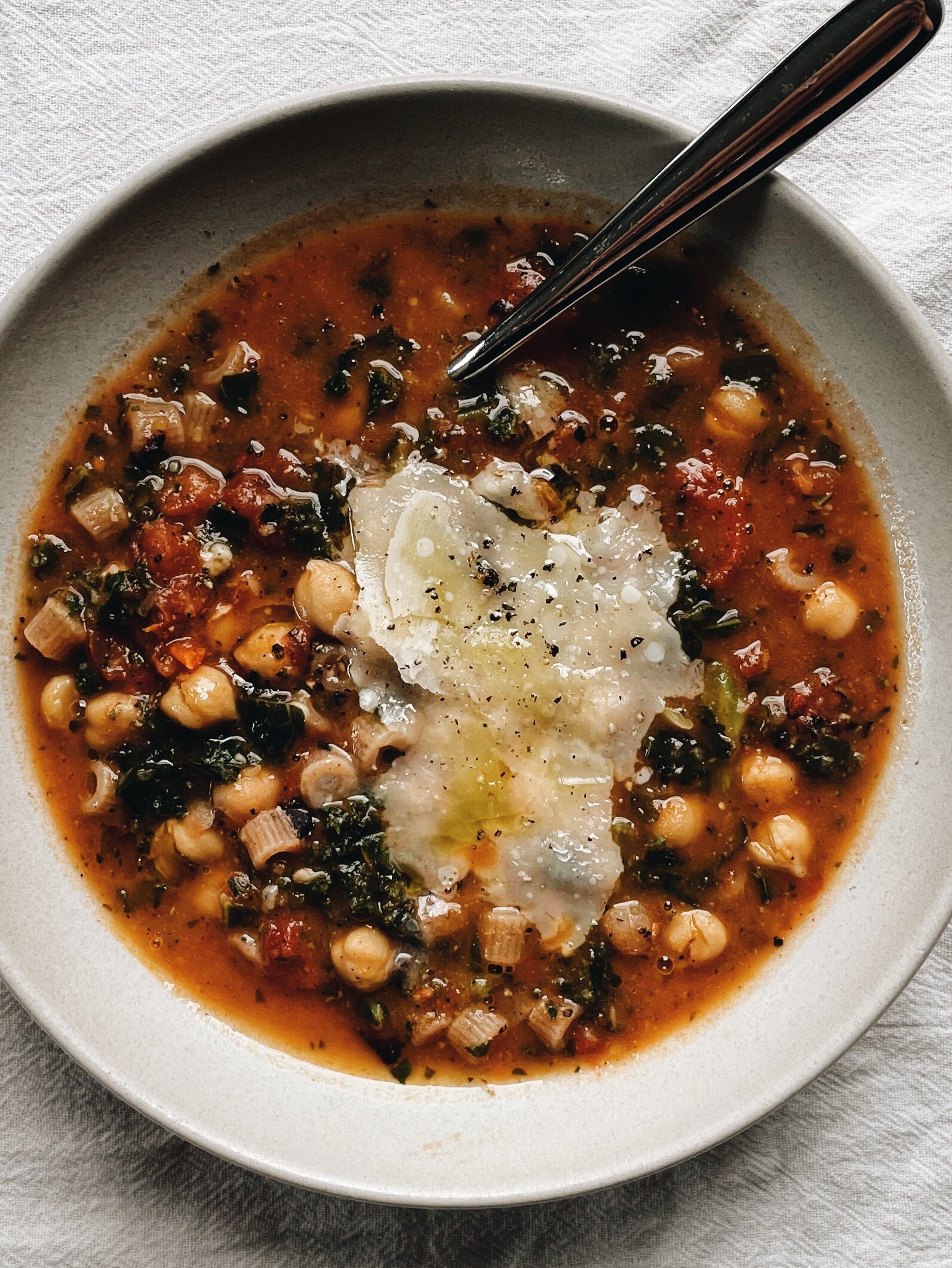chickpea minestrone – minestra di ceci
It’s rare, but sometimes I miscalculate my grocery shopping needs so badly that I’m almost surprised at my incompetence (I say almost because it’s happened enough times where it should be within the realm of expectation by now). It’s usually because I didn’t think about lunch.
This is when Pantry Soup™ enters the chat. A good one has the following qualities:
Inherently plant-based
Ability to make good use of remnant or languishing ingredients time forgot
Mostly made up of dry or canned goods people tend to have around in emergencies
My minimalist minestrone recipe is almost there, but would get disqualified because it has too many fresh vegetables. And yet…
Minestrone CAN be a Pantry Soup™ if you allow it to be. A “vegetarian by necessity” dish that pre-dates the Romans but I guess was popular in the Empire days, it took advantage of sturdy produce and dry goods, and hung around because people of the old world understood the true value that frugal soups add to military stamina. The range of qualifying minestrones is vast—they can be extra brothy (as my other one is) or more of a thick bean stew, tomato based or “green” (herbs only), pasta-rich or no pasta at all, with any kind of vegetables and any kind of stock—but for the most part all of them have beans, the one ingredient I always have on the shelf.
This one is specifically a minestronezation of chickpeas, and uses a trick I often use to thicken bean soups without using cream or dairy: simmering the beans in whatever base you’re using for about an hour, then hitting a small amount of it with a blender and recombining. The silky puree adds a luxe richness that’s native to the soup, meaning it doesn’t blunt the flavor the way cream can; it also anchors it more tightly to its roots as a peasant porridge, its intention from the beginning of time.
And that’s how I took a 10-minute break at 11am to throw some stuff in a pot and returned at lunch to this, an alt-minestrone made only of what I had: a bunch of canned chickpeas, fire roasted tomatoes intended for something else, herbs, broth, and lots of garlic, which went on to achieve a spectacular finish with help from a blender, frozen greens, cute noodles, and shaved cheese.
“Minestra” has its Latin roots in “to serve,” and let me tell you, Minestra di Ceci is here to do just that.
RECIPE
An ultra-minimalist (but still entirely vegetarian) spin on the traditional minestrone, made with chickpeas and other pantry ingredients for a cozy, healthy-enough soup that’s ideally suited to those weird, cooler, maybe-it’s-fall days and nights.
Effortful time: 10 minutes
Total time: 1 hour 10 minutes
Makes 6 medium-sized bowls
YOU NEED
1 tbsp. olive oil
2 cloves garlic, minced
1 tbsp. double-concentrated tomato paste
2 cans chickpeas/garbanzo beans, drained and rinsed
28 oz can. diced fire roasted tomatoes
4 cups low-sodium chicken or vegetable broth (I had chicken bone broth around, so that’s what I used)
1 tbsp. Italian herb blend of your choice
1 tsp. granulated onion powder
1/2 tsp. dried rosemary (unless your Italian seasoning has rosemary in it; if so, omit it)
1 tsp. salt
8 oz. frozen chopped kale or spinach
1 cup small, chunky noodles, like ditalini or small shells
Shaved parm, olive oil, and freshly cracked black pepper for serving
MAKE IT
Prep your ingredients. This soup moves quick, so have everything ready to go.
Cook your flavor base. In a large dutch oven (5 qt +) heat the olive oil over medium-low heat. Sauté the garlic for about 30 seconds, or until just fragrant. Immediately add the tomato paste and break up with your cooking utensil, sautéing for about 30 seconds more until the tomato paste and garlic create a delicate melange of pizzeria perfume. You don’t want the garlic to brown at this stage, so work quickly.
Tomato time. Add the fire roasted tomatoes and stir to combine. This will stop the garlic from overcooking.
Now build your soup. add the chickpeas, Italian herbs, onion powder, rosemary, salt, and broth to the pot. Lower to a minimal simmer and partially cover.
Simmer. This needs to hang out now for about 40 minutes to an hour. I quickly put it on the stove at 11am, knocked out some work, and came back to it at noon.
Optional but really worthwhile: blend it. Ladle 2 cups of the soup into a blender or, my preferred, an immersion-blender-safe vessel (I like silicone measuring cups; they make it easy to pour the soup back into the pot afterward). Blend it, either the old-fashioned way or with a stick blender, until it forms a thick puree. Pour this back into the soup.
Add pasta and greens. Cook to either one’s package directions, whichever is longer.
Finish it. Ladle into bowls and top with parm, a drizzle of oil, and fresh pep. For crunch, I like these parmesan whisps as a soup crouton.
Note
Pasta is notorious for sucking up broth in the fridge overnight, so you may need to add more broth when reheating.

